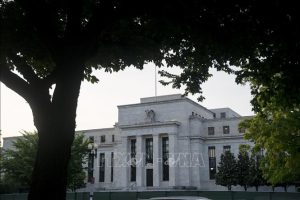In many major economies, the central bank rate-cutting cycle is coming to an end.

Headquarters of the Bank of England (BoE) in London. Photo: THX/TTXVN
However, Reuters news agency (UK) commented that some places such as the US Federal Reserve (Fed) and the Bank of England – which acted more cautiously in the first half of the year – could still continue to loosen a little more.
This week, Australia, Sweden and Norway all decided to keep interest rates on hold, as did the Bank of England.
The Swiss National Bank (SNB) has kept interest rates unchanged since cutting its key rate to zero in June. Markets expect interest rates in Switzerland to remain at that level. Recent Swiss government data showed inflation unexpectedly fell to 0.1% in October, but analysts say this will not be enough to prompt the SNB to cut rates into negative territory.
The Bank of Canada, grappling with U.S. tariffs and the impact of inflation, cut its key interest rate to a more than three-year low of 2.25% last week. The bank has also eased policy more aggressively than many of its developed-market peers, but is now sending strong signals that the easing is over. Traders predict that the Bank of Canada is unlikely to cut rates again this year or next.
Sweden’s central bank (Riksbank) on November 5 kept its policy rate unchanged at 1.75% and said it would maintain this level “for some time” unless there were new developments in inflation or growth.
The European Central Bank (ECB) kept its deposit rate at 2% last week, signaling the resilience of the European economy. Traders say the ECB’s easing cycle is nearing its end, with the probability of a further rate cut before July 2026 below 50%.
The Reserve Bank of Australia (RBA) on November 4 left the cash rate unchanged at 3.6% as expected, saying it was cautious about easing further given higher inflation, strong consumer demand and a recovering housing market. Inflation in the third quarter was stubbornly high, but markets now see little chance of further easing until 2026. RBA Governor Michele Bullock said there may not be any further rate cuts.

Headquarters of the US Federal Reserve (Fed) in Washington, DC, USA. Photo: THX/TTXVN
The US Federal Reserve (Fed) announced on October 29 a further 0.25 percentage point interest rate cut – the second consecutive cut in 2025 – to respond to rising risks in the labor market, amid growing internal divisions over the policy direction of the agency. The interest rate cut was met with opposition from two policymakers, with Governor Stephen Miran calling for a deeper cut and Kansas City Fed President Jeff Schmid “wanting to keep the current interest rate” as inflation remains above target. Strong data this week further narrowed expectations, and traders now price in only about a 60% chance of the Fed cutting interest rates by 25 basis points in December, down from 84% before the meeting.
On November 6, the Bank of England’s interest rate makers voted overwhelmingly to keep interest rates unchanged at 4%, paving the way for a rate cut in December following the government’s key budget announcement on November 26. The Bank of England said the risk of further weakening demand in the economy and the risk of persistently high inflation had eased.
The Bank of Japan (BOJ) decided on October 30 to keep its key interest rate unchanged at around 0.5% after a two-day policy meeting. But it reiterated its commitment to continue raising borrowing costs if the economy develops as forecast, shifting investors’ attention to its December meeting. US Treasury Secretary Scott Bessent has urged the Bank of Japan to accelerate the pace of interest rate increases to avoid a sharp slide in the yen.













Leave a Reply